Chapter 6
Chapter 6. The Analytical Task of “Contextualizing the Domain of Knowledge”
6.1. Introduction
Figures 3.3–3.5 (Chapter 3) show a second stage in the thematic description (that is, description of the content) of an audiovisual text or a specific passage therein: the contextualization of the knowledge object identified beforehand.
The term “contextualization” here is used in the sense of “referential contextualization”. This is the procedure which explicitizes the referential framework – the perimeter – of the knowledge object. In that sense, contextualization denotes a descriptive task, which, along with that of describing the knowledge object (see Chapter 5), constitutes the task of referential description*. Remember that the task of referential description, in turn, forms one of the four main tasks of a specific type of analysis of an audiovisual text, known as thematic description* (or description of the content) – the three others being the description of the discourse production* around a topic, the description of the audiovisual expression* and/or verbal expression of the topic and, finally, the meta-textual commentary (which, for instance, facilitates the explicitation of the framework – the “point of view” – of the content analysis itself).
To begin with, referential contextualization can be broken down into spatial contextualization and temporal contextualization . In our research regarding the analysis of audiovisual corpora, we focused particularly on these two forms of contextualization in order to be able to experiment with localization on geographical maps and chronological localization on timelines of subjects and themes developed in the audiovisual corpora analyzed. This is a fairly popular approach to access the textual content of digital archives and libraries [GUE 11; LEM 11b; DES 11d].
However, there is a third form of contextualization which comes under the general umbrella term of thematic contextualization. This third form explicitizes the context – social or institutional, historical or cultural, epistemological, etc. – of the knowledge object described beforehand. We have not systematically developed this third form of contextualization. For the moment, we use it only in the context of the description of subjects which deal with the domains or objects or research in human and social sciences. For instance, Austrian literature from the late 19th Century and the first half of the 20th Century obviously constitutes the topic of a great many researchers and concrete research activities. However, thematic contextualization of the object of research here enables a researcher’s particular interest in that object, his objectives and his theoretical references, to be explicitized. Thus, it is an extremely important form of contextualization which could, in the long term, enable us to better profile and hierarchize the results obtained following information requests (à la Google) of the type “identify all textual and audiovisual resources which deal with Austrian literature at the end of the 19th Century and the first half of the 20th as an object of research (historical, aesthetical, semiological, etc.)”.
Section 6.2 briefly describes the problem of contextualizing an object dealt with in an audiovisual text by way of its spatial location. Section 6.3 deals with geopolitical location and, more specifically, location by country, which is the most usual form. In section 6.4, we again briefly look at geographical (physical) location as such, i.e. location in what is known as natural space.
Sections 6.5 to 6.7 discuss the temporal but also historical location of the subjects and themes mentioned in an audiovisual text.
Finally, section 6.8 offers a brief discussion relating to a concrete example of thematic contextualization.
6.2. Contextualization by spatial location
One of the main forms of contextualization of a knowledge object thematized in an audiovisual text being described by the analyst is its location in space. Given the nature of our working audiovisual corpora (audiovisual resources documenting domains of knowledge which correspond to the various experimentation workshops of the ASW-HSS project – domains such as cultural diversity, heritage and archaeological research, or even literary heritage), certain forms of spatial location are very present whereas others are not. Thus, “geographical” contextualization in the broader sense of the term is clearly omnipresent in our working corpora, whereas contextualization of a knowledge object in an abstract space (e.g. geometric space1) is not.
A first form of location of the knowledge object is that which we call geographic in the broader sense of the term. This includes physical space as a support for location, both in the sense of a social space (a “socially constructed” space) and of a natural space.
Figures 3.3 and 3.4 show the example of the treatment of this form of location based on physical space (social or natural). More precisely, we see the following at work:
– a form of location which we define by the expression geopolitical, including an even more specific form of location which (for want of a better term) we call administrative (or territorial) location;
– and a form of geographic location, said to be physical.
It is sequence 2 (see Chapter 3, Figure 3.3) of the form for describing audiovisual corpora devoted to the topic [Civilization in America] which is given over to geographical location in a natural space. Sequence 3 (see Chapter 3, Figure 3.3), on the other hand, is dedicated to the forms of description which we call geopolitical and territorial.
So-called geopolitical and, more particularly, territorial location uses the socially constructed and informed spatial environment as a means of locating its objects, whereas geographical, so-called physical location relies on the natural environment. In the former case, it is areas and localities such as agglomerations, habitats, administrative territories, zones and regions with cultural, economic, military value, etc. which serve as “locators”. In the latter case, it is the lie of the land and natural formations which serve to locate a knowledge object.
As regards so-called geopolitical location, we can see that this constitutes a particular case of location which relies on social space, or on space which has a meaning for a human actor (a person, a group, a society, a state, etc.)2. Alongside this form of location, there exists (of course) a very diverse range of other forms of location which rely on social space. It is the specificity of the corpus of analysis and the universe of discourse* which decides the possibility of explicitizing a particular form of locating a knowledge object.
Let us simply note in passing that a form of location is always equipped with a double specification:
1. a thematic specification: this specifies the type of social space required in order to locate a knowledge object – the space of daily life, the space organizing the world of work, etc.;
2. and a functional specification: this specifies the role played and the value held by a particular place for the knowledge object being located (this is space in its narrative function, to quote Greimas [GRE 76]: places of qualification, places of reconnaissance, places of testing, but also euphoric or dysphoric places, places with an epistemic or deontic function and so on).
6.3. Location and contextualization by country
One of the most widespread forms of so-called geopolitical location of the knowledge object thematized in an audiovisual text is location by country. Figure 3.4 (Chapter 3) offers us a simple example of this. It shows us that this form of location is carried out as three successive activities. The realization of each of these activities is entrusted to a thematically and functionally specialized subsequence (see also Figure 6.1).
Figure 6.1. Canonic structure for carrying out the task of geopolitical location of a knowledge object by country
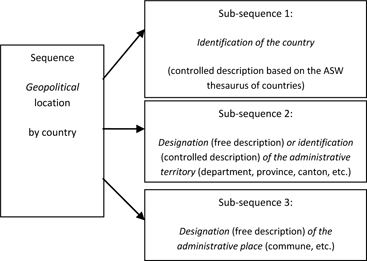
In a first sub-sequence (Figure 6.1), the analyst identifies the relevant country in the ASW micro-thesaurus of contemporary countries. Thus, here it is a question of a procedure of controlled description* which the analyst can carry out, if he so desires, by producing a short explanatory presentation.
In a second sub-sequence (Figure 6.1), the analyst may choose (although it is not obligatory!) to describe the territory in the administrative sense of the term (in the USA, the state or county; in the UK, the shire, district or borough, etc.; in France, the département or région; in Germany or Austria, the land; in Switzerland, the canton, etc. For certain countries, the ASW thesaurus has lists of administrative territories. Of course, this is so for France, but also for Peru and Bolivia, given that these two countries form the geographical, political and cultural world of one of the experimentation workshops of the ASW-HSS Project, devoted to the intangible cultural heritage of Andean communities (see Figure 6.2, which shows an extract from the AICH micro-thesaurus relating to the administrative regions of Peru)3. If a country’s administrative territories are to be found in the AICH thesaurus, their identification to locate a knowledge object is performed by way of a procedure of controlled description; if not, the analyst freely enters whichever territory is relevant for his topic.
Figure 6.2. Extract from the AICH micro-thesaurus of Peru’s administrative regions – micro-thesaurus compiled by V. Legrand [LEG 11a]
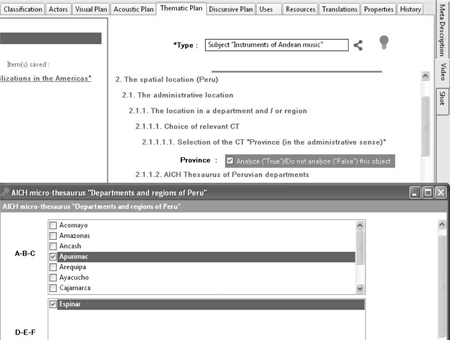
In a third sub-sequence, the analyst may, if he so desires, freely describe the more specific administrative place which serves to locate the knowledge object thematized in an audiovisual text. For the corpora identified, we have identified a particular type of administrative places represented by the conceptual term [Commune]. If the analyst so wishes, he may freely enter the name of the commune, provide an additional summary presentation of it, and then classify it using a small micro-thesaurus containing a whole series of culturally diverse types of communes (<Borough>, <Lieu-dit>, <City>, <Village>, <Hamlet>, <Agricultural commune>, etc.).
We can see that the succession of these three sub-sequences defining the structure of the so-called geopolitical location by country is motivated by the movement from global to local: from a global location of the knowledge object thematized in an audiovisual text to its local and more circumscribed location. More specifically, this means that the first sub-sequence is pre-supposed for the second and third. In order to specify an administrative territory and/or a commune, the analyst first has to specify the country.
So-called geopolitical location by country (see Figures 3.4 and 6.1) is merely one thematic variant of this form of spatial contextualization. However, it is the most widespread, and for our own working corpora, is also the most productive.
However, it is entirely possible, on the basis of the existing ASW metalinguistic resources, to construct other forms of geopolitical location which take into account, e.g. geostrategic territories, common spaces formed by groups of countries, linguistic spaces, religious spaces, spaces based on professional and economic activities, etc.
In terms of the procedures of description to be used to locate a knowledge object thematized in an audiovisual text by country, again we use the two procedures which we have already seen in the previous chapter – namely the procedure of free description and that of controlled description. In our example (see Figures 3.4), the analyst proceeds as follows:
– (procedure of controlled description): he first selects <Peru> in the ASW micro-thesaurus of contemporary countries – a micro-thesaurus which is associated with the descriptive task Location by country (Figures 3.4);
– (procedure of controlled description): he then selects <Ancash> in the ASW micro-thesaurus of (administrative) regions of Peru today (Figures 3.4);
– (procedure of mixed description – free and controlled): finally, he enters the expression <Chavín de Huantar> to denote the conceptual term [Commune] and its category – using the ASW micro-thesaurus of administrative toponyms under the term <Village> (Figures 3.4).
The procedure, as we have just explained it, is sufficient to allow us to locate the subjects dealt with in the various audiovisual corpora by country, to a satisfactory degree. However, it should be added that it is very easy to complement this approach by way of various extensions which enable us to considerably enrich the concrete results of a description of location by country as we have just presented it.
In this vein, let us cite the FAO’s geopolitical ontology4 which indeed constitutes a potentially very enriching extension to our approach. The FAO’s geopolitical ontology operates with a canon of conceptual terms which is noticeably similar to the canon we use to geographically locate a knowledge object dealt with in an audiovisual text or corpus, including terms such as [Zone], [Territory], [Country], etc. However, the FAO’s geopolitical ontology goes a great deal further, of course, in defining models for describing a country or territory, e.g. including concepts for determining:
– a country’s historical ancestors (e.g. the USSR as the forefather of Russia);
– the border(s) of a country;
– a country’s membership of a group of countries and/or an organization;
– the GDP of a country;
– the various codes for referring to a country, etc.
All this information can automatically be integrated into a basic procedure of geographical location such as the one presented above, and made available to any interested audience5. The FAO example also demonstrates the interest of being vigilant – constantly and as systematically as possible – as regards the interoperability of the descriptive metadata produced via a particular approach to the analysis or description of corpora of data.
Finally, it seems important to underline another fact: that a sequence of geopolitical location used in the context of one analysis of audiovisual corpora may be re-used, exactly as it is or following certain modifications and adaptations in the most diverse use contexts – e.g. in the context of the analysis of geopolitical data relating to a country, a group of countries, etc.
Indeed, here we see new problems in knowledge engineering rear their heads, such as putting in place libraries of models and bricks* (schemas or sequences) of models of description, completely inter-defined and shared by the most diverse of users working in the context of the constitution, conservation and diffusion/appropriation of digital knowledge heritage.
6.4. Geographical-physical location and contextualization
Alongside so-called geopolitical and administrative location, as has already been discussed, there is a second form of spatial location which is concerned with the geographic location per se of a knowledge object thematized by an audiovisual text, i.e. its (possible) location in a natural physical space.
Figure 6.3. Extract of the ASW micro-thesaurus of regions of the American continent
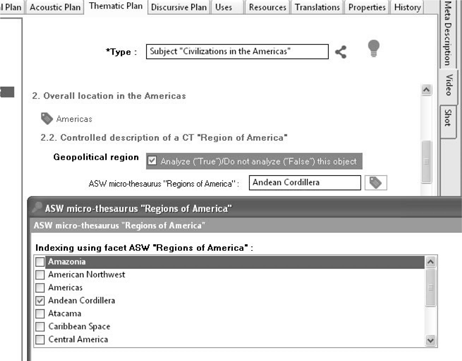
Figure 3.3 shows a simple example of such a procedure of physical geographic location. The example relates to the geographical location of the remnants of the Chavín technical culture on the altiplano of the Cordillera Blanca in Peru. As we can see in Figure 3.3, the task of physical location (which is a specialized task of spatial contextualization of a knowledge object thematized in an audiovisual text) is taken care of by a specific sequence in the model of description. In our example, it is the second sequence in the model of description with which we can describe audiovisual corpora concerned with subjects relating to one or more civilizations, past or present, on the American continent. The procedure of description itself, made up of various specific activities of description, is carried out in two stages:
1. Firstly, we carry out a macro-location of the knowledge object thematized in the audiovisual text (or in such-and-such a passage therein). In our case, that macrolocation leads us to the mountain range <Andean Cordillera> which runs across South America from north to south. The macro-location of a knowledge object is carried out by way of the first sub-sequence of the sequence reserved for geographical location (see Figure 3.3).
2. Secondly, the macro-location is complemented by a more specific location which identifies the place, the exact site where the object thematized in the audiovisual text is physically to be found. In our example, this is the <Cordillera Blanca> which is situated in the Peruvian region of <Ancash>. This more specific location is taken care of by the second sub-sequence of the sequence in charge of describing the physical geographical location. Using a specialized micro-thesaurus, the analyst may still, as shown in Figure 6.4, determine the type or genre of the physical place serving to more precisely locate the object thematized in the audiovisual text. In our case the site in question is a <High plateau> or <Altiplano>.
Figure 6.4. Extract from the ASW micro-thesaurus of physical geographical types of territories
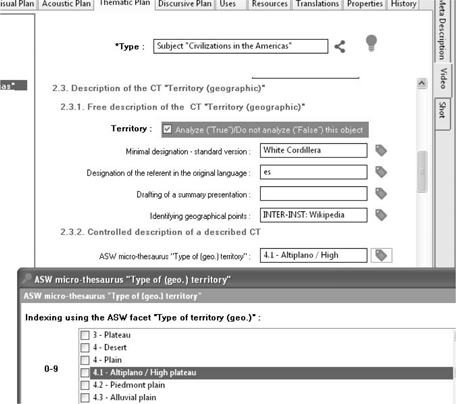
This process of successive and ever-more-precise locations can be refined if we wish to produce even more detailed physical locations. However, as a general rule, the distinction between these two levels is largely sufficient. The first level of location, macro-location, is a sort of general framing, while the second level corresponds to the circumscription of the place, the region which is truly meaningful for locating the knowledge object thematized. Let us note in passing that the same functional distinction between two (or else between several) levels of location is also to be found in the context of administrative location of a knowledge object.
Figure 6.5. Extract from the ASW micro-thesaurus “Regions of the world” (OntoEditor view)

As part of our research, we have been able to identify and compile into a microthesaurus a whole series of physical expanses which can play the role of “macrolocators”, or more circumscribed physical locations for the knowledge objects thematized in the audiovisual corpora which, as has already been discussed many times, stem from the collection compiled by our ARA (Audiovisual Research Archives) program6. This includes continents, the major regions by continent, water courses, oceans, seas, mountain ranges, large plains, large forests, deserts, etc. Figure 6.5 shows an extract. Alongside this “worldwide” micro-thesaurus, we have also defined a series of micro-thesauruses of large physical expanses by continent and/or “part of the world”. As Figure 6.3 shows, for describing the macro-location of the knowledge object Chavín technical culture, we used the ASW micro-thesaurus of physical expanses on the American continent. Certain physical expanses are to be found in both micro-thesauruses (in particular, this is the case of the <Andean Cordillera>, the <Caribbean region> or indeed the <Atacama> desert). This merely shows that an expression (usually nominal) belonging to the ASW thesaurus may be characterized by several facets* (of meaning) and therefore belong to several microthesauruses (a micro-thesaurus representing a particular facet of meaning).
Let us specify, however, that the choice to interpret a certain category of physical expanses such as macro-places is entirely based on the nature of the audiovisual corpus with which, and on which, we are working. Thus, if the universe of discourse* of an archive is inherently limited, e.g. to a country or a region, it goes without saying that the list of relevant macro-places has to be adapted to the universe of discourse in question. This adaptation is fairly easy to carry out, on condition, of course, that we know the relevant macro-places:
– we first compile an ASW micro-thesaurus of the relevant macro-places (for the universe of discourse of a particular archive);
– then in sequence 2 (Figure 3.3) we replace the ASW micro-thesaurus “Regions of the Americas” with the “correct” micro-thesaurus.
If the universe of discourse of an archive has no need of these macro-places or if the physical macro-places are not relevant for contextualizing the knowledge objects thematized in an audiovisual corpus (as is the case, for instance, for a corpus relating to classes in the history of mathematics), sequence 2 is then simply omitted.
Now as regards identification of the more circumscribed geographic site (see the second phase of the task of geographic location), it has been left to the analyst to identify and describe this “freely”. That said, if the universe of discourse of an archive is sufficiently circumscribed, and if we know, a priori, all the places which may be useful to more specifically locate a knowledge object thematized in an audiovisual text, then the procedure of free description can be replaced by one of controlled description. In that case:
1. we must first compile the thesaurus of places of location, i.e. the thesaurus which a priori defines the rank of the values of the conceptual term [TERRITORY] (see Figure 4.3);
2. then, remove the activities of description making up the procedure of free description of a physical territory;
3. and, finally, replace them with a procedure of controlled description made up of a micro-thesaurus of more circumscribed places from which the analyst chooses the appropriate place during his work of describing an audiovisual text.
The advantage of using the procedure of controlled description is plain to see here: the additional work beforehand (relating to the definition and constitution of one or several micro-thesauruses) is handsomely compensated later on by a reduction in the time of analysis (this becomes considerably longer if free description is used).
Controlled description also enables us to maintain a maximum degree of homogeneity in the results of the analyses carried out by different analysts, because these analysts have to use pre-defined terms to talk about their textual objects (which is obviously not the case with free description).
In addition, the pre-defined terms in a micro-thesaurus can a priori be provided with extra information to enrich a concrete analysis. Thus, for instance, every region listed in a micro-thesaurus can a priori be enriched with location coordinates (thereby freeing the analyst from having to carry out that task himself, which could quickly become time-consuming and tedious). It can be referenced in resources exterior to the ASW metalinguistic system. For instance, a particular region of the world can be referenced in the Wikipedia textual database. Finally, any area or place which figures in an ASW micro-thesaurus can be classified a priori and form part of a classification, such as the one shown in Figure 6.5, without the analyst having to carry out such a classification himself each time he enters a new place or area.
6.5. Contextualization by temporal location
As already mentioned at the start of this chapter, contextualization by temporal location is a second form of contextualization of a knowledge object thematized in an audiovisual text. We shall distinguish two more specialized forms here:
1. the first is actual chronological location of a knowledge object;
2. the second is historical location, i.e. pinpointing a knowledge object with the help of eras making up a particular history (human history, national history, cultural history, scientific history, etc.).
Figure 3.5 shows a very simple example of a functionally specialized sequence of a form for analyzing the audiovisual content which offers a succinct analysis of both the chronological and historical location of a knowledge object. Our example deals with the technical culture of the Chavín civilization in Peru in the 4th Century B.C. – a period which is sometimes called the <pre-Moche era> (that is, a historical period situated before the time of the Moche civilization, which first appeared around the 1st Century B.C. in a valley of the same name in Peru).
Technically speaking, this sequence can be broken down into three activities to be carried out by the analyst:
1. the first activity (which is obligatory) can be reduced to simply selecting the sequence’s unique conceptual term – in this case, the conceptual term [Century];
2. the second (which is also obligatory) consists of identifying the relevant century or centuries in a chronological list of centuries (a list which is part of the ASW thesaurus). In our example (Figure 3.5), it is the <4th Century> and the <3rd Century> B.C.;
3. the third activity (which is optional) consists of chrononymic designation of the selected centuries which, from a certain historical point of view, form an era, an epoch or a period. In our case, the two centuries selected form part of the epoch which the analyst has denoted as <Pre-Moche era>.
The sequence shown in Figure 3.5 indeed constitutes a simple and robust sequence which is often sufficient to locate a knowledge object thematized in an audiovisual text with a certain degree of precision. However, there are a whole series of cases where it is not sufficient, including the following four:
The sequence shown in Figure 3.5 indeed constitutes a simple and robust sequence which is often sufficient to locate a knowledge object thematized in an audiovisual text with a certain degree of precision. However, there are a whole series of cases where it is not sufficient, including the following four:
1. precise chronology: precise date (of an event), precise period (beginning, end, duration), radiocarbon timescales, etc.;
2. approximate, rough chronology: unknown dates, partially known dates, approximate indications of dates, etc.;
3. historical periodization: eras/epochs/periods, etc. periodization which is variable depending on the historiographical tradition and/or on the domain (national history, etc.);
4. finally, a chronological term which is a historical term as well (for instance, 18th Century French can be interpreted both as a historical epoch and a temporal period, etc.).
We have attempted to specify and develop a collection of sequences for describing the temporal context of a knowledge object which enable each of these four scenarios to be taken into account. In addition, this collection of sequences draws the distinction between sequences which represent a simple and pre-defined configuration (such as that represented by the sequence shown in Figure 3.5) and more complex sequences which enable the analyst to carry out relatively finegrained historical pinpointing.
This, of course, is the objective of an analysis of an audiovisual corpus that determines which of the sequences in question are the most appropriate to cater for the analyst’s specific needs.
Figure 6.6. Temporal location by period of a knowledge object thematized in an audiovisual corpus
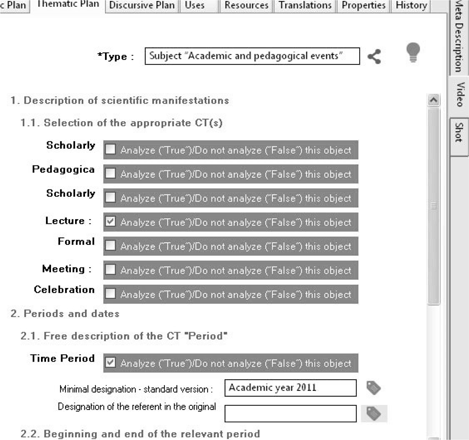
Figure 6.6 shows an extract from a model of description*, which we use to identify the periods and precise dates of an academic event (a conference, a seminar, etc.). Here, for illustrative purposes, the temporal location sequence entitled “Period and dates” is uncharacteristically placed in second position, just after the sequence of description of the knowledge object “Academic or pedagogical event”. The sequence in question has a general structure (it can be used to temporally locate any event, any activity for which we know the exact dates of the beginning and the end) and is perfectly simple to employ. However, using it presupposes that the analyst knows the precise dates of an event thematized in an audiovisual text.
6.6. Contextualization by historical era
The second scenario cited above is that of approximate temporal location. This is not necessarily based on partial knowledge, but often on knowledge which, in the audiovisual text being analyzed, is not expressed in the form of an exact date. Thus, the text can be contextualized in reference to an era, a reign, a reference historical event, concomitant historical events, etc. These “strategies” of historico-temporal contextualization can be pursued in the absence of a chronological reference stricto sensu (a year, a century, etc.) or in a mixed form: partly in the form of a reference to a specific date, partly in the form of a qualitative reference, non-numerical but comprehensible for anyone who possesses the necessary historical skills.
This is the case, for instance, with the important dates in a researcher’s life: a first expedition, a discovery, a crucial meeting for his/her intellectual development, academic failures or triumphs. All these types of events (which, understandably, are organized according to Greimas’ famous narrative schema [GRE 79]), may be accompanied by chronological references, but by no means have to be.
We have attempted to take account of this qualitative (and narrative) type of temporal contextualization in describing the knowledge objects stemming from the domains of expertise of the ASW-HSS project. Figure 6.7 shows an extract from a model of description of audiovisual corpora which deal with one or more languages (families of languages, dialects, protolanguages, etc.). The extract shows sequence 4, dedicated to the historico-temporal contextualization of the knowledge object being thematized (in our case, the evolution of the languages of the West-Semitic domain between the 12th Century B.C. and the 1st Century A.D.).7
Figure 6.7. Identification and temporal location of a historical era (first part)

In the first sub-sequence (Figures 6.7 and 6.8), the analyst is invited to denote the historical era in which the knowledge object thematized in the audiovisual text being analyzed is located. In other words, the analyst himself decides what to call that historical period. Thus, it is a procedure of so-called free description* (see Chapter 9) of the relevant historical context.
Figure 6.9, on the other hand, shows an example of controlled description of the relevant historical context. In this concrete example, it is a question of historically locating a French archaeological site in the era <France in Celtic times> (this era forms part of the ASW micro-thesaurus devoted to named eras in the history of France).
Figure 6.8. Identification and temporal location of a historical era (second part)
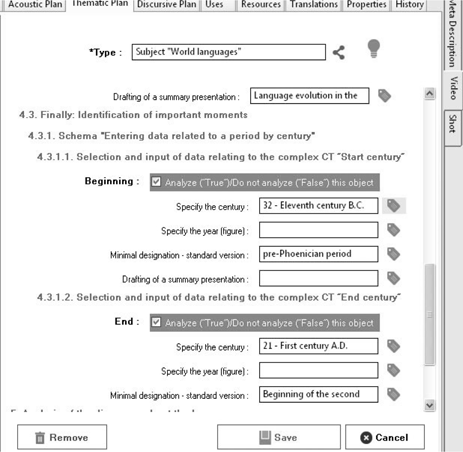
Let us return to our example from Figures 6.7 and 6.8. Once the analyst has filled in the first sub-sequence (Figures 6.7), i.e. has specified that his knowledge object (in this particular case, the Evolution of West Semitic languages) is situated in the historical period of the last millennium B.C., he can then carry out a chronological location per se (see Figures 6.7): in the ASW micro-thesaurus which offers an (open-ended) list of centuries, the analyst can select the century or centuries which are relevant to pinpoint “his” era.
Thus, in our case, he will be able to select all the centuries between the 12th Century B.C. and the 1st Century A.D., but he may also select only those centuries which are relevant for his subject and/or which are actually cited in the audiovisual text being analyzed.
Finally, if he so desires, the analyst can also specify certain important dates within a previously-identified era. Figure 6.8 only shows the two main dates – the beginning and end of an era. Figure 6.10, on the other hand, shows a sequence enabling us to identify and explicitize one or several dates (moments, periods, etc.) which form part of a chosen historical era.
Figure 6.9. Identification and temporal location of a historical era using the procedure of so-called controlled description
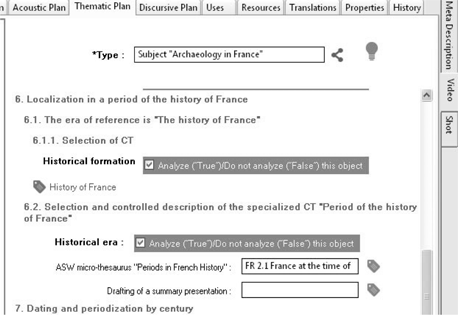
In our case, the analyst identifies the <Reign of Louis XIV> as a particular period during the era known as the <French Classical Age>. This reign serves him as a historical marker to locate the subject French culture – cultures of France dealt with in the text being analyzed (see Figure 6.10).
The expression <French Classical Age> is part of a micro-thesaurus dedicated to the periods of French history (Figure 6.11). Of course, for other national histories, appropriate micro-thesauruses of historical eras must be used. Figure 6.12 shows a micro-thesaurus which we use to contextualize knowledge objects in the history of China.
Figure 6.10. Identification of a specific period forming part of a historical era
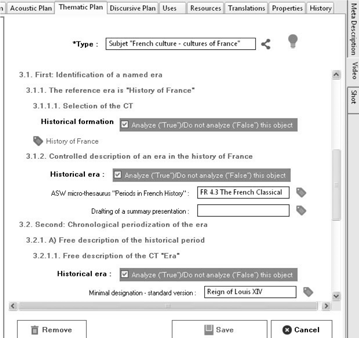
Figure 6.11. Extract from the ASW micro-thesaurus containing the different eras in the history of France

6.7. Historical contextualization and periodization
Figure 6.10 shows another case of chronological and historical contextualization. Here, it is a question of producing a periodization based on existing historical knowledge which serves the analyst as a reference point. In our example, it is the history of France, subdivided into periods which, preliminarily, appear valid to specialists in that field. These eras are identified in a specific micro-thesaurus, which forms part of the ASW thesaurus (Figure 6.11). Of course, this micro-thesaurus can be adapted, replaced or simply used alongside other micro-thesauruses devoted to the eras of French history.
In the example shown in Figure 6.10, the analyst’s work is organized as follows:
– 1st stage: the analyst identifies the history, the historical formation for which the existing periodization in the form of eras is valid. In our case, it is the history of France.
– 2nd stage: the analyst identifies the era(s) relevant for his task of analysis which consists of finding the historical context which is appropriate and pertinent for his work. Here, it is the era of the French Classical Age.
Figure 6.12. Extract from the ASW micro-thesaurus containing the different eras in Chinese history

These two stages form a sub-sequence which is pre-supposed by all the other sub-sequences making up sequence 3 devoted to the contextualization (of a knowledge object thematized in the audiovisual text being analyzed) in the history of France.
– 3rd stage: the analyst can now undertake a more fine-grained periodization which is adapted to the object of his analysis. He begins to describe the particular period in question and which is situated either within an era or across two or more eras figuring among the named eras listed in the ASW micro-thesaurus. In our case, the period in question is the reign of Louis XIV, which constitutes a specific period in the era <French Classical Age>.
– 4th stage: the analyst then proceeds as described above: he can – if he so desires – chronologically or simply qualitatively position the period in question (i.e. the reign of Louis XIV) and/or such-and-such a particularly important date therein (here, dates are only given for the beginning and end of the period, but the underlying reference model can easily integrate other functional types of dates).
Even if the analytical task of historico-temporal contextualization seems rather complex, the construction of models which can support this type of assessment is not. All things considered, only part 3.1 of Figure 6.10 has to be adapted: choice of the type of history and then of the micro-thesaurus containing the named eras for the type of history in question. For instance, Figure 6.12 shows the use of a microthesaurus containing the main (recognized) eras of Chinese history. It replaces the micro-thesaurus containing the named eras of French history. The rest of the model of description remains identical.
The aim of this section was to demonstrate the possible ways of going further than the simple chronological pinpointing of the objects thematized in an audiovisual text by also trying to provide tools to locate them in their appropriate historical contexts, while bearing in mind that the periodization depends on the type of history (and the historiographic approach) and that there can be no “true” periodization of history.
6.8. Thematic contextualization
This form of contextualization, as has been said in the introduction to this chapter (section 6.1), enables us to explicitize the social or institutional, cultural or historical, epistemological or mental framework of a knowledge object dealt with in an audiovisual corpus. This type of framework is often called the thematic framework. We prefer to use the term axiological framework in order to stress the fact that it is the relevant environment in accordance with which a knowledge object takes on its own meaning, its own interest, its own value for the text or corpus in which it is being spoken about. By speaking of the axiological framework, we therefore wish to reinforce that dimension of value which is intrinsically attached to any object thematized in a text.
As has already been discussed in the introduction to this chapter, this form of contextualization has not been systematically developed in our research. We have used it, above all, in the context of the description of audiovisual corpora which form part of the collection of audiovisual archives of the Fondation Maison des Sciences de l’Homme in Paris – a collection which is made up essentially of interviews with researchers, recordings of research seminars or indeed of conferences or other scientific events.
Figure 6.13. The theme [Discipline] in its function as an axiological (thematic) context
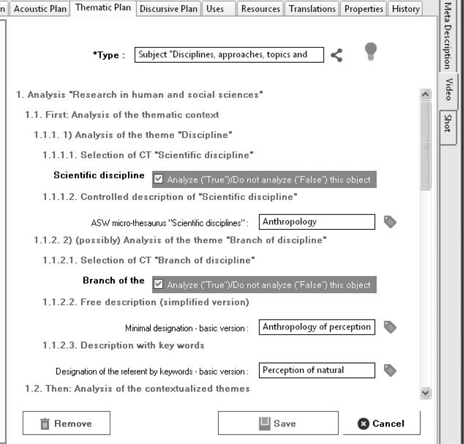
In this extensive collection of several thousand hours of digital videos, one of the most recurrent subjects, of course, is the presentation of a discipline or a disciplinary approach such as, for example, historical anthropology, cognitive sociology, history of sciences, town planning or museology which – along with so many other more or less well-known disciplines in the human and social sciences – make up the epistemological and theoretical framework for the research activities of a particular researcher or lecturing researcher: the identification of issues relevant to the research, the definition of what is at stake and what the objectives of the research are, the approach to and treatment of the object of the research.
Figure 6.14. The themes [Research activities], [Research themes], etc. in their function as contextualized themes
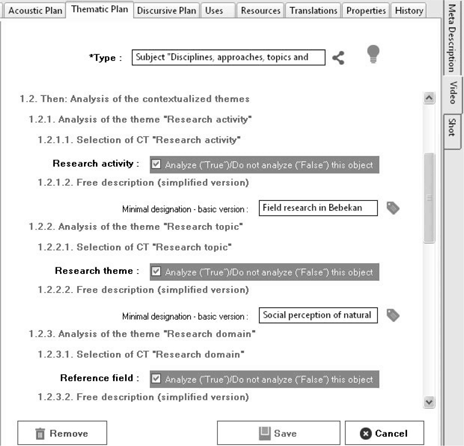
Figures 6.13 and 6.14 show how we deal with this question in our approach to the analysis of audiovisual corpora in which this kind of subject is thematized. For instance, in the context of description of the content of an interview with a researcher where the parties discuss the themes, domains, objectives, activities, results, consequences, etc. of a particular researcher’s work (a lecturing researcher, a junior researcher, etc.), the analyst is first invited to specify the thematic framework which constitutes the reference context for these questions (Figure 6.13). In our case, the thematic framework is constituted by the conceptual term [Discipline], within which the analyst has to specify by selecting one or more disciplines collected in a micro-thesaurus. He may or may not further specify this axiological framework by providing a free description of one or more of the “sub-disciplines” concerned. Obviously, that sub-sequence serving to describe the thematic framework according to which (or “in” which) a set of questions is dealt with, can be enriched by a far more developed topical structure – again, everything depends on the aims of the analysis.
Once he has provided information as regards the thematic or axiological framework (in our case: the disciplinary approach), the analyst, in a second stage, has to provide information as regards the various subjects treated in reference to the so-called thematic framework. As we can see in Figure 6.14, these are subjects represented by conceptual terms such as [Research activity], [Theme of the research], [Domain of the research], [Objectives of the research], etc. Depending on the audiovisual text to be described and the aim of the description, the analyst will provide one or other or indeed all of these conceptual terms, forming a topical structure which is simple but fairly robust.
The distinction between a thematic framework made up of, at least, the conceptual term [Discipline] and the themes or subjects contextualized in reference to that framework (such as those represented by the conceptual terms like [Research activity], [Theme of the research], etc.) acquires all its meaning when it comes to analyzing audiovisual corpora in which the thematic or axiological frameworks themselves seem to be very similar, or even partially identical. This is the case, for instance, when dealing with a corpus of interviews with researchers working on a common object such as culture, but coming at it from (sometimes only slightly) different points of view: a cultural history point of view, a cultural anthropology point of view, an angle on the sociology of cultures, an angle on the semiotics of cultures or indeed a point of view on the philosophy of the culture.
As has already been discussed, Figure 6.13 represents a very simple topical structure which defines a type of thematic or axiological framework. We are well aware that the “disciplinary” point of view is never “theoretically neutral”, but always depends on a certain underlying vision (theoretical, philosophical, etc.). Thus, speaking from the point of view of cultural history, we suppose that this point of view is, in fine, determined by a reference to an author, a school of thought, a scientific paradigm, etc.
As it is, the topical structure shown in Figure 6.13 does not enable us to give an account of these very significant nuances in a scientific assessment. However, thanks to its modular structure, it is relatively simple to add to sequence 1.1 (Figure 6.13) a third sub-sequence devoted to explicitizing intellectual or theoretical references which determine the position of the researcher and of his/her work in such-and-such a discipline.
To conclude these few reflections on the distinction between the thematic framework and the theme contextualized – and thus a third form of contextualization of an object thematized in a text being analyzed – let us add that, in our opinion, this is very important for correctly conducting an activity such as monitoring, assessing and reconstituting information (audiovisual or otherwise). Indeed, it seems to us that the added value of any information whatsoever lies more in its references to an axiological framework than in its denotative or referential dimension.
However, this is one of the paths of research which we would like to explore further in years to come, particularly in reference to the semiotics of cultures, i.e. to the semiotics of the framework of references [TAY 98] which serves as a standard [STO 88; STO 89; STO 05] for a person or social group to “read”, “interpret”, “understand” and finally “exploit” or “consume” an audiovisual text as a work, as a cognitive resource.
1 Along with our colleague Dominique Flament, a researcher in the history of mathematics at the CNRS (Centre National de la Recherche Scientifique – French national center for scientific research), we have just started a project aimed at analyzing the audiovisual content of a sizeable collection of recordings of research seminars, conferences and interviews with researchers in (the history of) mathematics, with a view to setting up an audiovisual archive devoted to the history of mathematics and, more specifically, to geometries (to use D. Flament’s expression). In this context, locating knowledge objects in abstract space naturally becomes a major issue. For the ASW metalanguage, this project will therefore constitute an excellent opportunity to enrich its conceptual vocabulary (i.e. its meta-lexicon of conceptual terms) and its thesaurus, and to expand its empirical field of application. For further information about the corpus compiled by D. Flament and his collaborators from 2000 onwards, see the ARA portal which, in the “Mathematics” section, offers access to some 130 hours of recorded material: http://www.archivesaudiovisuelles.fr.
Forgive us another small personal note here: it was with D. Flament and his large-scale conference on geometry in the 20th Century, in 2001, that we commenced our activities of collecting, analyzing and publishing audiovisual corpora devoted to scientific and cultural heritage – activities which, very soon (see [STO 11a]), resulted in the setting up of the “Audiovisual Research Archives” program; (to consult the contributions to this conference on 20th Century geometry, see: http://semioweb.msh-paris.fr/geometrie2000/presentation.htm).
2 These are forms of location which rely on human geography, which ultimately constitutes only a specific type of location relying on a space of meaning (a general semiotic space), along with forms and procedures of location using anthromorphological spaces (that is, imaginary, fictitious spaces) or indeed using spaces such as those which regiment the lives of natural species.
3 We refer here to the AICH (PCIA in French) workshop [LEG 11a]; see the official portal of the workshop: http://semiolive.ext.msh-paris.fr/pcia/.
4 For further information: http://www.fao.org/countryprofiles/geoinfo.asp.
5 Technically speaking, this integration is done by synchronizing either the conceptual terms of the conceptual schemas or sequences of an ASW model of description with the ontology or resources external to ASW. This synchronization is done using the OntoEditor tool, which we use to define the metalinguistic resources for analyzing audiovisual corpora and archives (see Chapter 11, section 11.8 for a brief presentation of this tool).
6 See http://www.archivesaudiovisuelles.fr/FR.
7 This subject was touched upon by the French philologer André Lemaire (Ecole Pratique des Hautes Etudes) in an interview conducted in 2005 as part of the ARA program: http://www.archivesaudiovisuelles.fr/390/introduction.asp.
